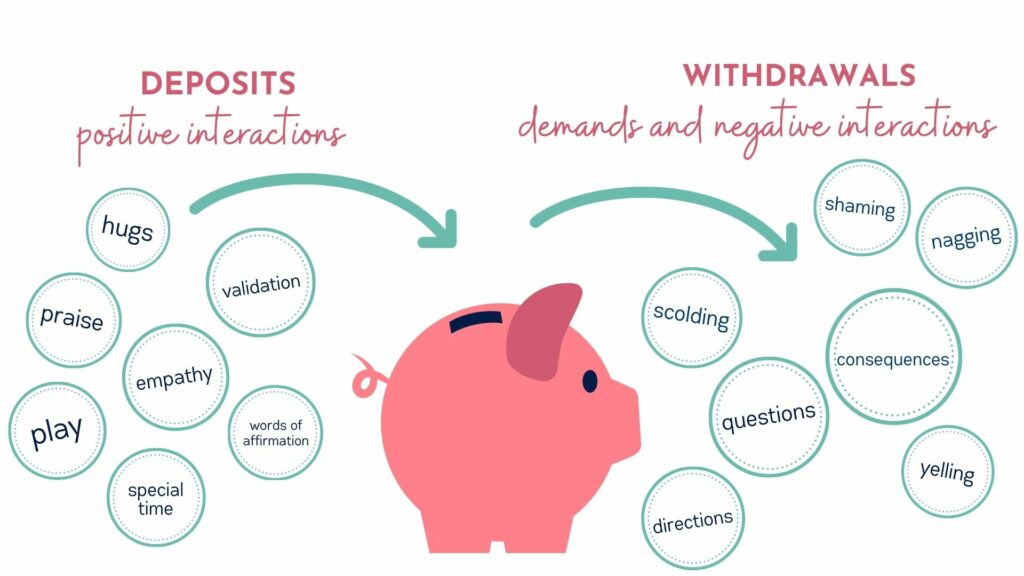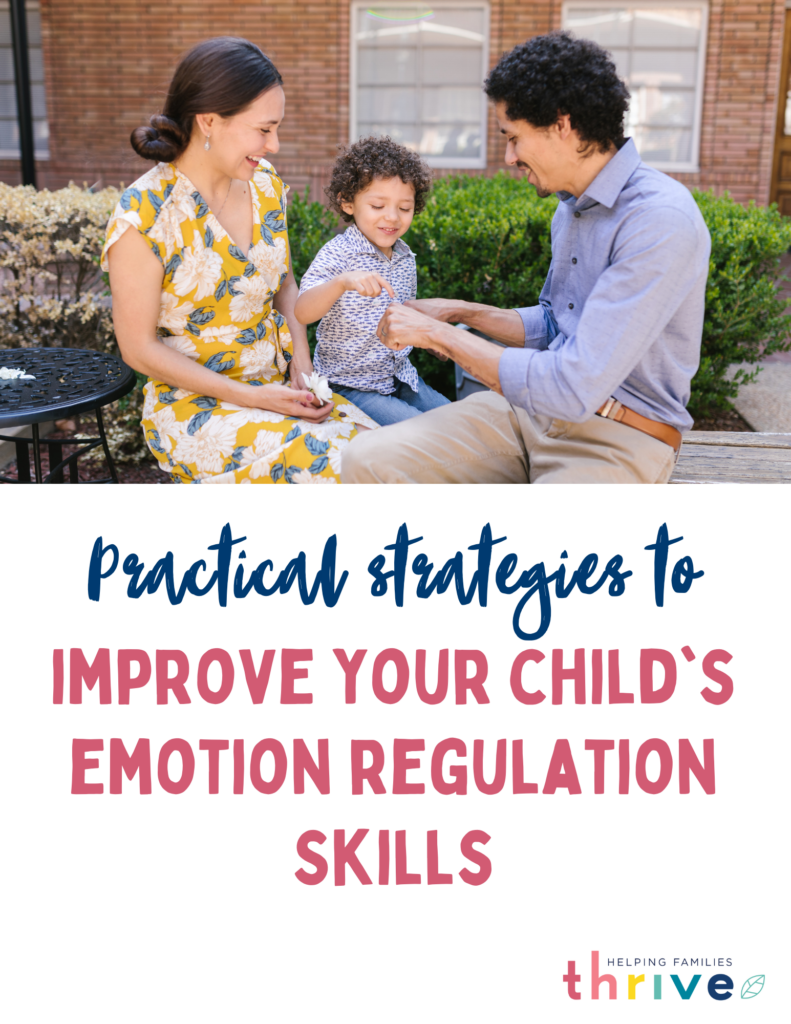
One of the most common reasons come to us for support is because they are experiencing challenging behaviors from their child. Parents want to know how to stop the hitting, tantrums, defiance or other less-than-desirable behaviors their child is displaying! This makes sense. Parents want to know how to best respond in these tricky situations. However, our solution very rarely starts with telling parents how to respond to those behaviors. Instead, we start with prevention and relationship building.
The foundation of prevention when it comes to emotion regulation and challenging behavior is the emotional piggy bank. This is a concept that comes from two well-known evidence-based interventions: The Incredible Years parenting program and the Gottman Method for romantic relationships. Yep, this concept doesn’t just apply to kids, it works for couples, too!
What is the Emotional Piggy Bank?
Imagine every child has an emotional piggy bank they carry around on their little chest. Throughout the day, each time a child is noticed, affirmed, or given time or affection, a deposit is made into their emotional piggy bank. Their “balance” goes up. Each demand or negative interaction is a withdrawal from the piggy bank. For more on withdrawals, click here.

Making sure there are many more emotional deposits than withdrawals is critical for ensuring a child doesn’t go into into overdraft. A child in emotional overdraft has no reserves. This means that when someone asks them to transition or do a less-than-desirable task, they have a big reaction that appears to come out of nowhere. That last withdrawal put them into overdraft!
As an example, think about all the instructions, questions, and corrections your child likely gets during the day at school. When they come home, you give one “simple” instruction and they explode or melt down. Essentially, that “simple” instruction crossed the threshold into overdraft.
One of the ways we can we prevent this “emotional overdraft” is by making more emotional deposits than withdrawals in a day.
We must be intentional about filling up the piggy bank so that the next time life throws our kiddos a curveball, they have the emotional balance to handle the hit. Deposits build resilience.
3 ways to increase Emotional Deposits
1. Child-led play (a.k.a. Special Time)
One of the most powerful ways we can make deposits into children’s emotional piggy banks and strengthen our parent-child relationship is through child-led play. Ten minutes of child led play per day keeps an emotional overdraft away!
Some of you may be thinking, “My kid is hitting me and you are telling me to play 10 minute a day?!” Our answer… “Yes!”.
As you know, children seek out control and attention — this is developmentally expected. Even though this desire for attention and control is normal, it can make things challenging for parents. This is where Special Time comes in. Special Time is your child’s daily dose of control. While young children cannot and should not always be in control, play is an appropriate area for them to take the lead!
When kids get this predictable dose of control and positive attention from their parents, they are less likely to seek control and negative attention at other times. They get out of “scarcity mindset” (when will mom be available again?). Special Time can be particularly helpful if there are siblings that tend to battle for parental attention.
Special Time basics:
- Schedule 10 minutes of daily 1:1 time with each child. Your first step is to look at your current daily routine and find a time when 10 minutes of child-led play can take place. For example, if at bedtime you typically snuggle or read books, you could insert 10 minutes of “mommy and Lucy playtime” in her room before you move to snuggles. Commit to this schedule as much as you can. If there are other adults in the home, you can alternate nights.
- Now that you have the child-led play set in your routine, begin to focus on sitting back and letting your child take the lead. This is your time to get lots of deposits in by describing, noticing, and praising your child’s behavior.
Note: This is just a brief overview of Special Time. In our online parenting course, Essentials, we spend an entire module on this tool because it is that powerful.
2. Mini-Moments
There are so many times in a day when our interactions are focused on getting things done and getting people moving. Picture the scene of a busy morning. You wake up, guzzle some coffee, make sure kids are fed and backpacks are ready. While your mental to do list is buzzing, your child is sitting at the table doing their own thing. With the Mini-Moment strategy, instead of waiting for our kid to ask for our attention (in a positive or negative way), put your coffee down and initiate just a “sprinkle” of attention. It’s a small “drive-by” positive interaction.
There are so many ways you can do this in a way that feels authentic to your family:
- Physical affection with a quick hug or kiss on the forehead
- A word of encouragement
- Tell them you love them while ruffling their hair
- Turn on a song and dance (for an older kid, embarrass them and pretend to twerk)
Let your guard down. Be silly and playful! (Interestingly, some research has shown a link between parental playfulness and child behavior and emotion regulation).
The more positive attention children get in this way, the less they are going to seek it in negative ways. Importantly, there doesn’t have to be a good behavior or a bad behavior for them to get this sprinkle of attention. You’re just loving on your kid. Every time you do this, you are filling up that emotional bank account.
Once you have seized this Mini-Moment to sprinkle your child with attention, pick up your coffee and resume what you need to do. It’s OK to not be able to sit and play all day. Little things matter! Or as Dr. John Gottman, one of the world’s leading experts on marriage and parenting says, “small things often.”
3. Stop and Respond
Our next strategy focuses on what to do when your child asks for your attention! The goal here is to stop what you are doing and respond briefly and warmly to your child’s bids for attention. This might be looking at what they want you to see or responding with a smile and pat on the shoulder. We want our kids to know that they don’t have to do something big (and potentially challenging) to get our attention! If we’re not responding to our kids when they’re asking appropriately, they will find ways to get our attention through their behavior.
Now, this doesn’t mean you always have to do what they want you to do — it’s okay to set boundaries. However, the way we do this matters.
Remember, the long-game to effective parenting is a combination of warmth and boundaries, so it’s essential that were setting this boundary in a way that protects our emotional piggy bank balance.
Here are some ways you can use this Stop and Respond strategy AND set boundaries:
- “Hi sweetie, I would love to play with you. I’m finishing up my coffee, and will be over to play with you in 5 minutes!”
- “Hey bud, I’m finishing up a work email, but I want to hear about the game. I’ll meet you on the couch in 5 minutes!”
- “Yes, I see you coloring your picture. You’ve picked lots of different colors. I’ll come sit with you in just a few minutes.”
Bonus? This works for adults, too. Dr. John Gottman refers to this approach as “turning toward” our partners and responding to bids.
Notice that none of these emotional deposit tools require you to be a Mary Poppins, constantly playing, and perfectly positive every waking hour! These are small moments and interactions that accumulate to make a big impact.
To learn how to minimize emotional withdrawals from the piggy bank, check out our post here. For a comprehensive approach to parenting based on evidence-based programs, get our Essentials online course for parents of children ages 2-10.






22 Comments
Comments are closed.